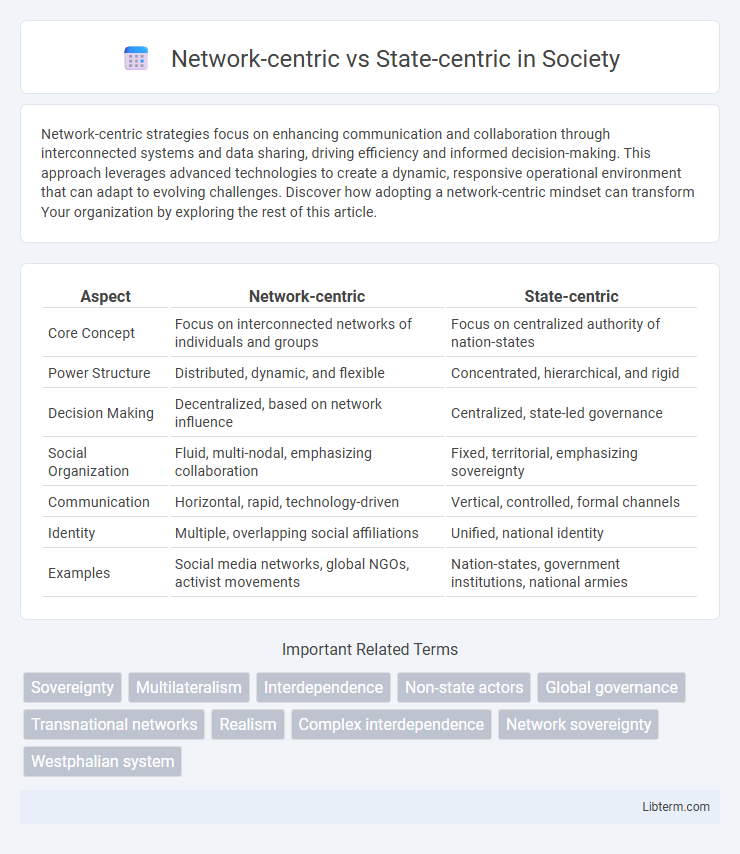Network-centric strategies focus on enhancing communication and collaboration through interconnected systems and data sharing, driving efficiency and informed decision-making. This approach leverages advanced technologies to create a dynamic, responsive operational environment that can adapt to evolving challenges. Discover how adopting a network-centric mindset can transform Your organization by exploring the rest of this article.
Table of Comparison
| Aspect | Network-centric | State-centric |
|---|---|---|
| Core Concept | Focus on interconnected networks of individuals and groups | Focus on centralized authority of nation-states |
| Power Structure | Distributed, dynamic, and flexible | Concentrated, hierarchical, and rigid |
| Decision Making | Decentralized, based on network influence | Centralized, state-led governance |
| Social Organization | Fluid, multi-nodal, emphasizing collaboration | Fixed, territorial, emphasizing sovereignty |
| Communication | Horizontal, rapid, technology-driven | Vertical, controlled, formal channels |
| Identity | Multiple, overlapping social affiliations | Unified, national identity |
| Examples | Social media networks, global NGOs, activist movements | Nation-states, government institutions, national armies |
Defining Network-Centric and State-Centric Approaches
Network-centric approaches prioritize decentralized, interconnected actors such as NGOs, corporations, and transnational coalitions that leverage information networks to influence global governance and security. State-centric approaches emphasize the primacy of sovereign states as the main actors in international relations, focusing on territorial control, national interests, and centralized authority. Defining these approaches involves contrasting network-centric models of diffuse power and collaboration with state-centric models centered on hierarchical governance and state sovereignty.
Historical Evolution of Security Paradigms
Network-centric and state-centric security paradigms reflect distinct historical evolutions rooted in geopolitical and technological shifts. The state-centric model, dominant during the Cold War, prioritized territorial sovereignty and centralized military power to address inter-state conflicts. In contrast, the rise of global communication networks and asymmetric threats in the post-Cold War era propelled the network-centric approach, emphasizing decentralized information sharing and collaborative defense mechanisms against non-traditional security challenges.
Core Principles of Network-Centric Models
Network-centric models emphasize decentralized decision-making, leveraging interconnected nodes to enhance agility and information sharing. Core principles include robust communication networks, real-time data exchange, and collaborative processes that enable synchronized operations across distributed entities. This approach maximizes situational awareness and operational efficiency by prioritizing network connectivity over hierarchical command structures.
Foundations of State-Centric Approaches
State-centric approaches in international relations emphasize the sovereignty and centrality of the state as the primary actor in global politics. These foundations rest on the principles of territorial integrity, national interest, and the legal recognition of states within a defined international system. State-centric theories prioritize the role of government institutions, power distribution, and diplomatic interactions in shaping international outcomes.
Comparative Analysis: Network vs State Priorities
Network-centric approaches prioritize decentralized information flow and agility, emphasizing collaboration among diverse actors to enhance responsiveness and innovation. State-centric strategies focus on centralized authority, control, and sovereignty, prioritizing national security and structured governance mechanisms. The comparative analysis underscores that networks excel in adaptability and real-time decision-making, while state-centric models ensure stability and enforce legal frameworks.
Influences on International Relations
Network-centric approaches emphasize the role of non-state actors, transnational networks, and information flows in shaping international relations, highlighting the decentralized and interconnected nature of global power. State-centric models prioritize sovereign states as primary actors, focusing on traditional power dynamics, territorial control, and formal institutions in diplomatic and security interactions. The influence on international relations varies as network-centric perspectives account for globalization and digital communication, while state-centric views underscore legal sovereignty and military capabilities.
Impacts on National Security Policies
Network-centric approaches enhance national security policies by enabling real-time information sharing, decentralized command structures, and increased operational flexibility. State-centric models, on the other hand, emphasize centralized authority and control, which can limit responsiveness but ensure cohesive strategic decisions. The shift toward network-centric frameworks influences policy development by prioritizing cyber defense, intelligence integration, and inter-agency collaboration to address asymmetric threats effectively.
Technological Advancements and Network-Centric Shifts
Technological advancements have transformed network-centric approaches by enabling seamless connectivity, real-time data sharing, and decentralized decision-making through innovations like cloud computing, 5G, and IoT integration. Network-centric shifts emphasize distributed intelligence and collaborative interactions over traditional hierarchical, state-centric models that prioritize centralized control and rigid command structures. This evolution enhances operational flexibility, situational awareness, and rapid adaptability in both military and commercial domains.
Challenges and Criticisms of Each Paradigm
Network-centric paradigms face challenges in maintaining cohesive control and ensuring reliable communication among decentralized nodes, often leading to vulnerabilities in security and coordination. State-centric models struggle with bureaucratic inefficiencies and rigidity, limiting rapid adaptation to emerging threats and dynamic global environments. Critics argue network-centric approaches can lack accountability, while state-centric frameworks risk over-centralization and suppression of innovation.
Future Outlook: Toward Hybrid Security Strategies
Network-centric approaches emphasize connectivity and information sharing across decentralized platforms, enhancing real-time threat detection and response capabilities. State-centric models prioritize centralized control and sovereignty, focusing on national interests and regulatory frameworks to maintain security. The future of security strategies lies in hybrid models that integrate network agility with state authority, leveraging advanced technologies like AI and blockchain to address complex cyber and geopolitical threats effectively.
Network-centric Infographic

 libterm.com
libterm.com